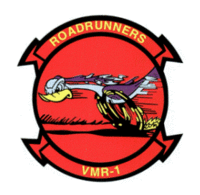VMR-1
| Marine Transport Squadron 1 | |
|---|---|
|
VMR-1 Insignia | |
| Active | July 16, 1941 - present |
| Country | United States |
| Branch | USMC |
| Type | Light Transport |
| Role |
fleet logistical support |
| Nickname(s) | Roadrunners |
| Engagements | Operation Desert Storm |
Marine Transport Squadron 1 is a light transport aircraft squadron of the United States Marine Corps. Also known as the "Roadrunners", the squadron is based at Marine Corps Air Station Cherry Point and falls under the Station command, along with Headquarters and Headquarters Squadron (H&HS). In addition to its military search and rescue duties, VMR-1 also serves the local community with its medical evacuation and search and rescue capabilities.
Mission
Provide Search and Rescue support to MCAS Cherry Point based aircraft as well as short and medium range rapid response/high speed multipurpose light transport of key personnel and critical logistics support to DoD. The squadron also provides wartime movement of high priority passengers and cargo with time, place, or mission-sensitive requirements flown in support of Department of Defense (DoD)-directed wartime operations and other critical Combatant Commander required worldwide wartime commitments.
History
Station Operations and Engineering Squadron (SOES), Marine Corps Air Station Cherry Point, North Carolina was conceived on July 16, 1941 when the United States Congress approved the purchase of a tract of land in the vicinity of the Neuse River in Craven County, North Carolina. On March 18, 1942, Colonel T. J. Cushman initiated flight operations at Cherry Point when he made the first aircraft landing at Cunningham Field. This was the real beginning of MCAS Cherry Point's flight operations and a very important moment in the development of SOES.
During January 1943, Aircraft Engineering Squadron 46 (AES-46) was commissioned. With over 1000 Marines, AES-46 was the largest aviation squadron in the Marine Corps and performed myriad airfield support operations. Among its assigned missions, AES-46 was responsible for Air Traffic Control, services to visiting aircraft, station communications, ordnance related activities, and care of the base magazine areas. Other support divisions manned by AES-46 Marines included airfield operations; crash, fire, and recovery; and station photo lab.
On October 1, 1951, the various responsibilities of AES-46 were redistributed between Station Operations Squadron (SOS-2) and Station Airfield Engineering Squadron (SAES-2). SOS-2 assumed the responsibilities for station operations, communications, crash crew, and photo lab; while SAES-2 Marines manned the engineering, rifle range, and ordnance sections. On February 24, 1954, Station Operations and Engineering Squadron was activated and assumed most of the special and technical activities originally performed by AES-46.

During 1979, SOES relinquished many of the duties previously assigned to itself and the former AES-46 to become responsible primarily for the operation and maintenance of its assigned aircraft. SOES was redesignated as Marine Transport Squadron One (VMR-1) in 1997, and remains a unique Marine Corps asset that operates two C-9B Skytrains, two UC-35D Cessna Encores, and three HH-46D Seaknight helicopters. The squadron operates its C-9B and UC-35 aircraft in myriad missions dealing with cargo and troop movement, in addition to the transportation of military and civilian dignitaries. Affectionately referred to operationally as “Pedro”, the HH-46D is primarily used for Search and Rescue (SAR) missions by MCAS Cherry Point and the United States Coast Guard when extended searches in eastern North Carolina are required. This helicopter will be replaced in late 2007 by an updated HH-46E version that incorporates enhanced capabilities and performance characteristics.
In February 1990, VMR-1 became the first Marine aviation unit to fly to the former Soviet Union when the squadron transported the United States Marine Corps Band to Moscow. From August 1990 through 1991, the squadron flew nearly 2000 hours moving troops and cargo in and out of the Middle East in direct support of Operations Desert Shield and Desert Storm. After Hurricane Floyd in September 1999, “Pedro” rescued 399 people directly threatened by the floods that followed and provided logistical support with emergency delivery of water and food supplies to volunteer workers and isolated communities throughout Eastern North Carolina.
Unit awards
- Meritorious Unit Commendation Streamer with four bronze stars
- Coast Guard Meritorious Unit Commendation Streamer with operational device
- National Defense Service Streamer with two bronze stars.
- Chief of Naval Operations Aviation Safety Award in 1990, 1991, 1993, 1995, 1996, 1997, 1998, 1999, 2000, 2001, 2002, 2003, 2004, 2005 and 2006
- Marine Corps Commandant's Aviation Efficiency Trophy - 1994
- Commandant of the Marine Corps Certificate of Commendation - 2000
- Joint Operational Support Airlift Center (JOSAC) Unit of the Year (Large Jet Category) - 2000, 2002
Aircraft
VMR-1 has the following aircraft:[1]
- 2 - UC-35
- 2 - C-9B Skytrain
- 3 - HH-46E[2]
See also
References
- Notes
 This article incorporates public domain material from websites or documents of the United States Marine Corps.
This article incorporates public domain material from websites or documents of the United States Marine Corps.
- ↑ LtGen George J. Trautman, III (2009). "2010 Marine Aviation Plan" (PDF). Headquarters Marine Corps. Archived from the original (PDF) on March 31, 2010. Retrieved 2010-01-05.
- ↑ LCpl Payne, Doug (December 20, 2007). "Pedro retires last HH-46Ds" (PDF). The Windsock. Marine Corps Air Station Cherry Point, NC. pp. A1 & A3. Retrieved 2008-07-25.
- Bibliography
- Web

